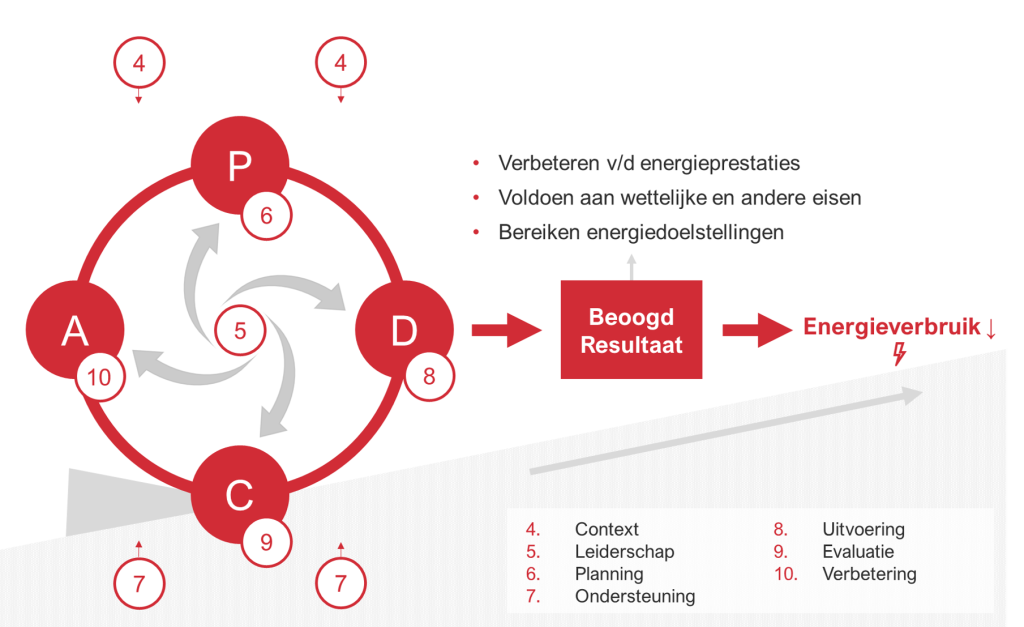ISO 50001:2018
ISO 50001:2018
As an organisation, do you want to improve your energy consumption and, in doing so, save costs and reduce the environmental impact of your energy consumption? Then the ISO 50001:2018 standard is an excellent guideline to achieve this.
What is ISO 50001?
Implementing an energy management system (EnMS) involves drawing up an energy policy , objectives (including actions to achieve these objectives) and energy performance indicators to monitor energy performance. When determining these objectives, the organization must take into account which devices, machines, departments, etc. consume the most energy and/or offer significant potential for improving energy performance (so-called significant energy consumption).
ISO 50001:2018
The United Nations Industrial Development Organization (UNIDO) recognized the need to develop an effective response to climate change and increasingly develop national standards for energy management and energy efficiency. For this reason, in 2007 the International Organization for Standardization (ISO) was asked to develop an international standard for energy management. The first version of ISO 50001 was finally published on June 17, 2011.
The second and latest version of the ISO 50001 standard was released in 2018, with the official name NBN EN ISO 50001:2018 in BelgiumThe structure has been adapted to the Harmonized Structure (HS) to simplify integration with other management system standards. In Belgium, the NBN (Bureau for Standardization) is responsible for the publication of (international and European) standards. As soon as a Belgian publication takes place, the standard automatically receives this addition. The 'EN' addition refers to the European publication by CEN-CENELEC..
Why ISO 50001 certification?
Implementing an energy management system and obtaining an ISO 50001 certificate has several advantages for both your own organization and the living environment. The certificate gives your customers the assurance that you are serious about your energy consumption, allowing you to distinguish yourself from competitors.
ISO 50001 certification contributes to a positive image for the organization as you can demonstrate that you are actively working on energy consumption and energy efficiency.
ISO 50001 certification is increasingly becoming a requirement for assignments or tenders from governments and large organizations. The organization will improve its competitive position compared to other (non-certified) organizations.
By implementing the ISO 50001 standard, an organization can reduce its greenhouse gas emissions as a result of energy use.
By implementing the ISO 50001 standard, an organization will improve its energy performance and associated energy costs.
The content of ISO 50001
ISO 50001 - like most ISO standards - has been drawn up according to the Harmonised Structure (HS) principal.This means that these standards have a common core text and the same structure. This ensures that themes discussed in each standard are always discussed in the same place (chapter & paragraph).
The standard consists of 11 chapters, which are shown below. The first four chapters (0 to 3) contain general explanations, while chapters 4 to 10 describe the core of the standard, i.e. the standard requirements.
| Chapter 0: Introduction | Chapter 6: Planning |
| Chapter 1: Subject matter and scope | Chapter 7: Support |
| Chapter 2: Normative references | Chapter 8: Implementation |
| Chapter 3: Terms and definitions | Chapter 9: Performance evaluation |
| Chapter 4: Context of the organisation | Chapter 10: Improvement |
| Chapter 5: Leadership |

Who is ISO 50001 intended for?
ISO 50001 is intended for any organization that wants to actively and systematically improve its energy consumption. Since every organization has some form of energy consumption (e.g. lighting, transport, heating/cooling, etc.), ISO 50001 is applicable to every organization, regardless of activities, sector and/or size..
ISO 50001 is a framework for setting up an energy management system; the organization can implement the specific requirements of the standard itself.
The ISO 50000 series
The ISO 50000 series helps organizations continuously manage their energy performance. The best-known – and only certifiable – standard in the series is ISO 50001. The other, additional guidelines serve as support and each focus on aspects such as auditing, communication, implementation techniques and energy measurements.
The main guidelines from this series are:
- ISO 50001 'Energy management systems – Requirements with usage guidelines'
- ISO 50002 ‘Energy audits — Requirements with guidance for use’
- ISO 50003 ‘Energy management systems — Requirements for bodies providing audit and certification of energy management systems’
- ISO 50004 ‘Energy management systems — Guidance for the implementation, maintenance and improvement of an ISO 50001 energy management system’
- ISO 50005 ‘Energy management systems — Guidelines for a phased implementation’
- ISO 50006 ‘Energy management systems — Measuring energy performance using energy baselines (EnB) and energy performance indicators (EnPI) — General principles and guidance’
- ISO 50009 ‘Energy management systems — Guidance for implementing a common energy management system in multiple organizations’
- ISO 50015 ‘Energy management systems — Measurement and verification of energy performance of organizations — General principles and guidance’